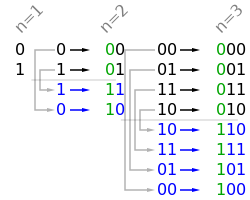The gray code is a binary numeral system where two successive values differ in only one bit.
Given a non-negative integer n representing the total number of bits in the code, print the sequence of gray code. A gray code sequence must begin with 0.
For example, given n = 2, return [0,1,3,2]. Its gray code sequence is:
00 - 0 01 - 1 11 - 3 10 - 2
Note:
For a given n, a gray code sequence is not uniquely defined.
For example, [0,2,3,1] is also a valid gray code sequence according to the above definition.
For now, the judge is able to judge based on one instance of gray code sequence. Sorry about that.
这道题是关于格雷码的,猛地一看感觉完全没接触过格雷码,但是看了维基百科后,隐约的感觉原来好像哪门可提到过,哎全还给老师了。这道题如果不了解格雷码,还真不太好做,幸亏脑补了维基百科,上面说格雷码是一种循环二进制单位距离码,主要特点是两个相邻数的代码只有一位二进制数不同的编码,格雷码的处理主要是位操作 Bit Operation,LeetCode中关于位操作的题也挺常见,比如 Repeated DNA Sequences 求重复的DNA序列, Single Number 单独的数字, 和 Single Number II 单独的数字之二 等等。三位的格雷码和二进制数如下:
Int Grey Code Binary 0 000 000 1 001 001 2 011 010 3 010 011 4 110 100 5 111 101 6 101 110 7 100 111
其实这道题还有多种解法。首先来看一种最简单的,是用到格雷码和二进制数之间的相互转化,可参见我之前的博客 Convertion of grey code and binary 格雷码和二进制数之间的转换 ,明白了转换方法后,这道题完全没有难度,代码如下:
解法一:
// Binary to grey code class Solution { public: vector<int> grayCode(int n) { vector<int> res; for (int i = 0; i < pow(2,n); ++i) { res.push_back((i >> 1) ^ i); } return res; } };
然后我们来看看其他的解法,参考维基百科上关于格雷码的性质,有一条是说镜面排列的,n位元的格雷码可以从n-1位元的格雷码以上下镜射后加上新位元的方式快速的得到,如下图所示一般。

有了这条性质,我们很容易的写出代码如下:
解法二:
// Mirror arrangement class Solution { public: vector<int> grayCode(int n) { vector<int> res{0}; for (int i = 0; i < n; ++i) { int size = res.size(); for (int j = size - 1; j >= 0; --j) { res.push_back(res[j] | (1 << i)); } } return res; } };
维基百科上还有一条格雷码的性质是直接排列,以二进制为0值的格雷码为第零项,第一项改变最右边的位元,第二项改变右起第一个为1的位元的左边位元,第三、四项方法同第一、二项,如此反复,即可排列出n个位元的格雷码。根据这条性质也可以写出代码,不过相比前面的略微复杂,代码如下:
0 0 0
0 0 1
0 1 1
0 1 0
1 1 0
1 1 1
1 0 1
1 0 0
解法三:
// Direct arrangement class Solution { public: vector<int> grayCode(int n) { vector<int> res{0}; int len = pow(2, n); for (int i = 1; i < len; ++i) { int pre = res.back(); if (i % 2 == 1) { pre = (pre & (len - 2)) | ((~pre) & 1); } else { int cnt = 1, t = pre; while ((t & 1) != 1) { ++cnt; t >>= 1; } if ((pre & (1 << cnt)) == 0) pre |= (1 << cnt); else pre &= ~(1 << cnt); } res.push_back(pre); } return res; } };
上面三种解法都需要事先了解格雷码及其性质,假如我们之前并没有接触过格雷码,那么我们其实也可以用比较笨的方法来找出结果,比如下面这种方法用到了一个set来保存已经产生的结果,我们从0开始,遍历其二进制每一位,对其取反,然后看其是否在set中出现过,如果没有,我们将其加入set和结果res中,然后再对这个数的每一位进行遍历,以此类推就可以找出所有的格雷码了,参见代码如下:
解法四:
class Solution { public: vector<int> grayCode(int n) { vector<int> res; unordered_set<int> s; helper(n, s, 0, res); return res; } void helper(int n, unordered_set<int>& s, int out, vector<int>& res) { if (!s.count(out)) { s.insert(out); res.push_back(out); } for (int i = 0; i < n; ++i) { int t = out; if ((t & (1 << i)) == 0) t |= (1 << i); else t &= ~(1 << i); if (s.count(t)) continue; helper(n, s, t, res); break; } } };
既然递归方法可以实现,那么就有对应的迭代的写法,当然需要用stack来辅助,参见代码如下:
解法五:
class Solution { public: vector<int> grayCode(int n) { vector<int> res{0}; unordered_set<int> s; stack<int> st; st.push(0); s.insert(0); while (!st.empty()) { int t = st.top(); st.pop(); for (int i = 0; i < n; ++i) { int k = t; if ((k & (1 << i)) == 0) k |= (1 << i); else k &= ~(1 << i); if (s.count(k)) continue; s.insert(k); st.push(k); res.push_back(k); break; } } return res; } };
参考资料:
https://discuss.leetcode.com/topic/8557/an-accepted-three-line-solution-in-java